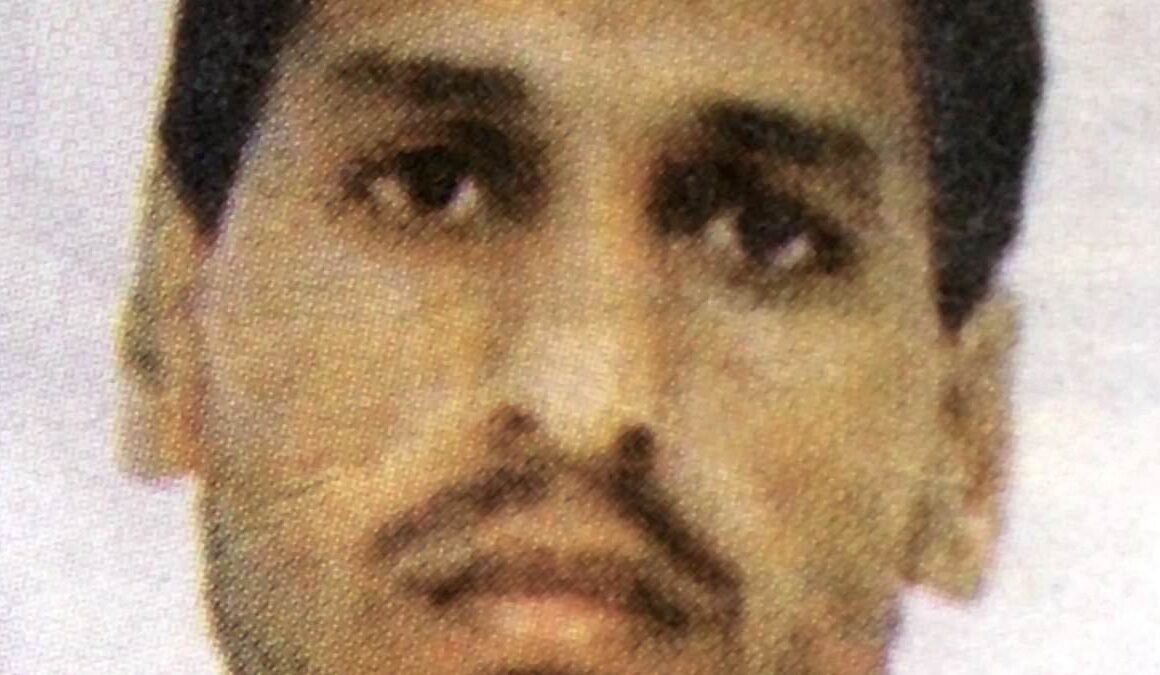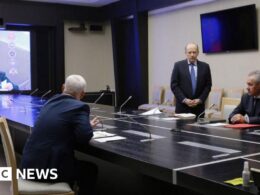Hamas commander Mohammed Deif has been assassinated in an airstrike, the Israeli military revealed today, a day after group leader Ismail Haniyeh was killed in Iran.
‘IDF fighter jets struck in the area of Khan Yunis, and following an intelligence assessment, it can be confirmed that Mohammed Deif was eliminated in the strike,’ the Israel Defense Forces said in a statement today.
The one-eyed Hamas commander was allegedly killed on July 13, confirmed Thursday after Hamas‘ political chief was killed by an ‘airborne projectile’ in Tehran. Israel has not claimed responsibility for Haniyeh’s death.
Deif is believed to have been responsible for planning and executing the bloody October 7 incursion into Israel, in which Hamas members and their allies killed some 1,200 Israelis and took some 240 hostage.

Mohammed Deif, the chief of Al-Qassam Brigades, was killed in an airstrike, the IDF claimed

Palestinians evacuate a body from a site hit by an Israeli bombardment on Khan Younis, southern Gaza Strip, on July 13

Mohammed Deif, the head of Hamas’s military wing (left), and Rafa’a Salameh, the commander of Hamas’s Khan Younis Brigade

Deif is believed to have been responsible for planning and executing the October 7 incursion into Israel

Israeli Defence Minister Yoav Gallant said the strike that killed Mr Deif was a ‘significant milestone’ toward achieving the goals of the war.
‘The results of this operation reflect that Hamas is an organisation in disintegration,’ he wrote on X, formerly Twitter.
Israel believes that Deif, the head of Hamas’s military, and Yahya Sinwar, the top Hamas leader in Gaza, were the chief architects of the October 7 attack.
Sinwar is believed to remain in hiding in Gaza.
The head of the Ezzedine al-Qassam Brigades, Hamas’s armed wing, Deif had been among Israel’s most wanted man for nearly three decades and on a US list of ‘international terrorists’ since 2015.
Israel had reportedly tried to kill him at least eight times – including in 2001, 2002, 2006, 2014 and in May 2021.
The attempts saw both of his legs and an arm blown off and his wife and two children killed.
Amid the ongoing war in Gaza, Israel targeted Deif in a strike on July 13 that hit a compound on the outskirts of the city of Khan Younis, but there had been no immediate confirmation he was killed.
More than 90 other people, including displaced civilians in nearby tents, were killed in the strike, Gaza health officials said at the time.
The house where Deif was believed to have taken residence was hit with a 2,000lb (900kg) bomb, leaving a giant crater.
One of the founders of Hamas’s military wing, the Qassam Brigades, the former bombmaker, who studied physics, chemistry and biology at the Islamic University in Gaza, had led the unit for decades.
He was arrested by Israel in 1989 and spent about 16 months in detention before rising through the ranks.
Under his command, it carried out dozens of suicide bombings against Israelis on buses and at cafes and built up a formidable arsenal of rockets that could strike deep into Israel.
He remained a mysterious, underground figure in Gaza. He never appeared in public, was hardly ever photographed and only rarely was his voice heard in audio statements.
Deif operated along with Yahya Sinwar, the Israeli military said.
‘During the war, he commanded Hamas’s terrorist activity in the Gaza Strip by issuing commands and instructions to senior members of Hamas’s military wing,’ it added.
There were rumours the sinister mastermind of the October 7 attacks had been killed earlier this month, but Israeli Prime Minister Benjamin Netanyahu said in mid-July it was ‘still not absolutely certain’ whether Deif was dead.
The announcement came a day after political chief Ismail Haniyeh was killed in an airstrike in Tehran.
Haniyeh, a multi-billionaire who had been living in exile in Qatar since 2019, was reportedly killed when an ‘airborne guided projectile’ hit his compound in Tehran. Israel has not claimed responsibility.
After being appointed to the Hamas top job in 2017, Haniyeh moved between Turkey and Qatar’s capital Doha, escaping the travel curbs of the blockaded Gaza Strip.
The role enabled him to act as a negotiator in ceasefire talks or to talk to Hamas’ ally Iran – and as a relay between hardline figures like Yahya Sinwar and the outside world.
But many living in the beleaguered Gaza Strip, including members of Hamas, became disillusioned with Haniyeh as he became removed from the lives of people on the ground.
‘The fact that he lived in a five-star hotel in Doha made him very unpopular with some of the Hamas figures on the ground in Gaza,’ Dr Andreas Krieg, associate professor of Security Studies at King’s College London, told MailOnline.
‘He’s not someone who the organisation is relying on very much. But it is clearly a very symbolic strike.’

Hamas chief Ismail Haniyeh, pictured in Iran on Tuesday hours before his death

Haniyeh (pictured right) joined other senior Hamas officials on a private jet, undated

Displaced Palestinians leave western Khan Yunis to areas in the eastern parts of the city following reports of Israeli forces withdrawing from the area on July 30

Smoke rises from an Israeli air strike in Rafah as seen from Khan Younis, in the southern Gaza strip, on July 29

Palestinians mourn for their relatives killed in Israeli airstrikes hit the eastern areas of Khan Yunis, at Nasser Hospital in Gaza City, Gaza on July 28

Palestinians mourn lost relatives following an attack on Gaza City in the north, on July 29
While Iran has vowed ‘revenge’ for Haniyeh’s death, it is not expected his killing will lead to a dramatic escalation of the regional conflict.
‘What this offers is a head on a silver platter,’ Dr Krieg added. ‘Netanyahu can say this is the end of the organisation. And that’s pretty much as close as Israel will ever get to defeating Hamas.
‘But that can only work if Israel says now ‘we’re willing to enter ceasefire talks.”
‘All sides don’t want all out war. All sides want to maintain their reputation. Nobody wants to lose face. These people are replaceable.
‘All sides will find a way in this tit-for-tat escalation to respond in measure beyond a certain ceiling… all sides have been pushing the threshold but on all accounts they have always tried not to breach it.’
In its 10-month-old campaign of bombardment and offensives in Gaza, Israel has killed some 39,480 Palestinians and wounded more than 91,100 others, according to Gaza’s Health Ministry, whose count does not differentiate between civilians and combatants.
More than 80% of the population of 2.3 million have been driven from their homes, the vast majority crammed into tent camps in the south-west corner of the territory, with limited food and water.







